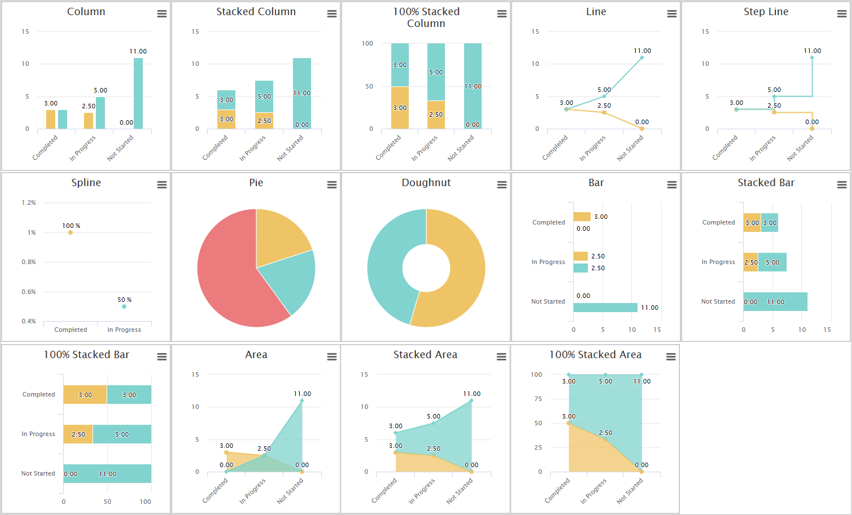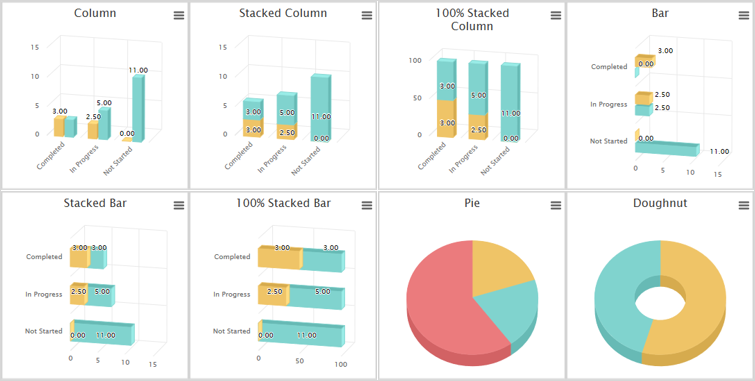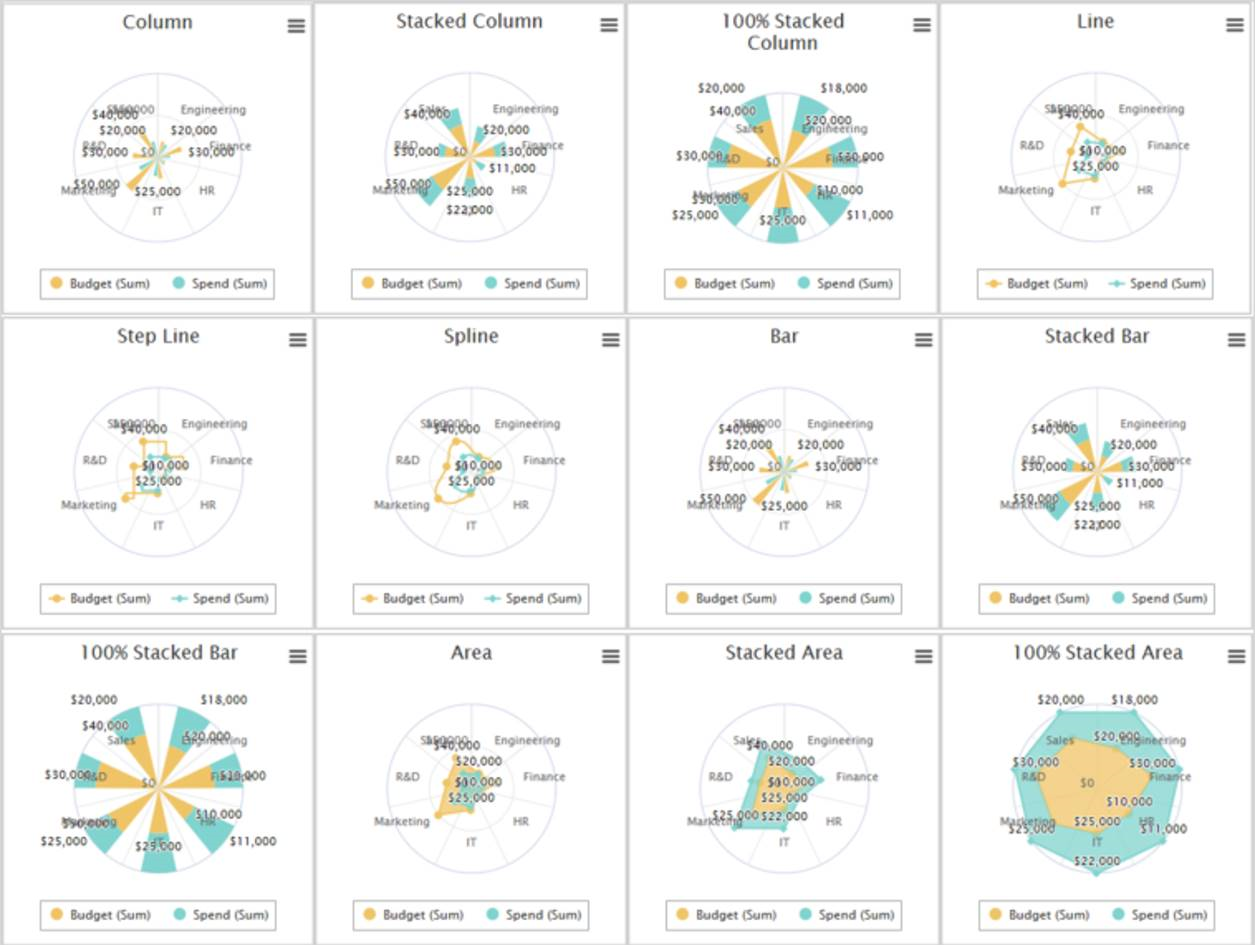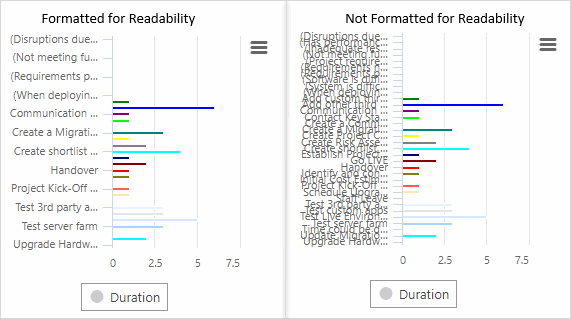Configure Chart Reports
This topic describes how to configure BrightWork Reporter Chart reports, including how to select the report you want to display.
The most commonly used configuration settings for Chart reports are available via the Shared Settings section on the Reporter ribbon. The Shared Settings section also includes a report filter dialog that is not available on the Reporter settings page.
You can also create a personal report via the Reporter ribbon.
The reports supplied with BrightWork Reporter are setup to report on the lists supplied with BrightWork and SharePoint. If columns are added to these lists you can add these columns to reports using the Report Editor. This will enable reporting on these columns.
Once you have configured your report, you can save it as a web part template to save you having to repeat your effort elsewhere.
Configure a Report
To configure a report:
- Click on the information icon
 of the report to open the Reporter ribbon.
of the report to open the Reporter ribbon. - Click Configure Reporter Settings then click one of the options and click OK.
Report Settings
Data Source
Select the data source.
Tip! Selecting a new Data Source, even temporarily, means that all custom report configuration settings could be lost. To avoid having to repeat any configuration effort, save reports as web part templates.
-
Work Cache
The Work Cache is primarily designed as an alternative to open work and issue reports that report across multiple sites. By default, all open items in the Work Cache are shown but you can filter the work items by any of the three out-of-the-box views: Open Work, My Work and Issues. This option only appears in the list of data sources if the Work Cache is activated. -
Project Cache
The Project Cache is designed primarily to speed up the loading of cross-site Project reports that report across multiple sites. By default, all items in the Project Cache are shown but you can filter the project items displayed by any of the three out-of-the-box views: All Projects, Open Projects and My Projects. This option only appears in the list of data sources if the Project Cache is activated. -
Project Status Report Cache
The Project Status Report Cache is primarily designed as an alternative to 'project status report' reports that report across multiple sites. By default, only the current project status report for a list in the Project Status Report Cache is shown but you can change this by selecting the All Project Status Report view. This option only appears in the list of data sources if the Project Status Report Cache is activated. -
BrightWork Reporter Library
This is where the reports you have created yourself are stored. -
Reporter Library
The BrightWork Reporter Library is where Report Definition files can be created and modified. -
Server Gallery
The BrightWork Server Gallery is a read-only gallery of Report Definition files. -
Custom Location
Custom Report Location is where you can reference Report Definition files in locations other than the two above.
Report Scope
Define the target site and specify whether or not to include the target site's subsites in the report.
-
Current Site
Selecting this option means that only the current site will be included in the report. -
Specified Site
This option is for specifying the SharePoint site to report off. Selecting this option enables the Specified Site field. The URL you supply must be server relative, for example: /sites/SiteName. -
Specified Site(s)
This option is for specifying a list of SharePoint sites to report off. Selecting this option enables the Multiple Site Locations field for you to enter site URLs.Note: Use a ; to separate the sites.
The URLs can be server relative (for example: /sites/SiteName) or fully qualified (for example: http://www.contoso.com/sites/SiteName).
Fully qualified URLs must point to sites on the same server as the site the report is running in.
You can also specify a single site here - the Specified Site option above is being maintained for legacy reasons.
-
Report XML
Selecting this option means the scope is defined in the report file - see Add or Edit a Query Source for more information.This option is not available for BrightWork Server Gallery reports.
Report Scope Location
Enter the location of the specified web that you want to report off.
This is only necessary if Specified Site is selected from the Report Scope menu.
Report Type
Select the Report Type:
Note: The Gantt Report and Resource Usage Report types will only appear if valid data exists to render the report. For example, if only one date column exists a Gantt or Resource report cannot be rendered.
-
Chart Report
-
Gantt Report
-
List Item Report
-
Resource Usage Report
Web Part Settings
Title
Enter a title for the report.
Chrome Type
Chrome types available are: Default, Border Only, None, Title and Border, and Title Only.
Rendering and Performance
Note: The Rendering and Performance section is not available when Project Cache or Work Cache is selected as the Data Source.
Site Filters
Select Enable to switch on the site filters defined in the Report Definition.
Site Filters are a way of excluding certain sites from being queried by BrightWork Reporter (for example, the default site filters ensure that BrightWork project sites that have a Status of (3) Completed and/or where Exclude from Reports is selected on the Project Statement are excluded from most reports).
You should only disable site filters if you need to do so on a case by case basis. If you wish to remove a site filter from all instances of a report, you should do so via the Report Editor.
Retention Duration
Select Enable and enter the number of seconds to retain the report's data.
A Retention Duration of 5 seconds for example, means that if the page is revisited within 5 seconds BrightWork Reporter will reuse the data. This is especially useful if there is a lot of data in the report, as it can take a few seconds to render first time. The report is retained on the server on a per user basis, up to a maximum of 3600 seconds (i.e. 1 hour).
Click the Refresh button on the Reporter ribbon to override the Retention Duration setting and display the most up-to-date content.
Site Name Caption
Not a chart option - should be greyed out.
List Name Caption
Not a chart option - should be greyed out.
Show Report Description
Choose whether you want the report description to display: Collapsed, Expanded or None.
Show Report Errors
Choose whether you want the report errors to display: Collapsed, Expanded or None.
BrightWork Reporter error messages can be very useful for debugging purposes, if you are creating your own reports or adding lists to your sites.
Report Profiler
The Report Profiler displays a report on all the sites and lists queried by an instance of a report, including how long individual sites and lists take to query.
Chart Type
Select a chart type.

3-D Charts
The following charts can be rendered in 3-D.

Polar Charts
The following charts can be viewed in polar:

Chart Data Binding
Select and define the columns that will be used to render the chart.
X-Axis
-
Column
Select the column to use as the X-Axis -
Sort Direction
Select the direction in which you want the items returned to be sorted -
Enable categorization for this column
Select whether you want all the list items returned to be grouped according to the values in the X-Axis column. Not selecting this checkbox means that list items returned will be individually displayed. -
Do not include data when the Y-column values(s) equal zero
Select to exclude items with a Y-column value of zero
Y-Axis
-
Display the number of items in this category
Select to display the number of items in a categorized X-Axis column - This option is only available if categorization is enabled for the X-Axis column
-
Column
Select the number column(s) to display along the Y-AxisFor most chart types you can select up to 10 Y-Axis columns. The exception are for Pie and Doughnut.
-
Formula
Select the formula to be used on the selected Y-Axis column data.This option is only available if categorization is enabled for the X-Axis column
The available formulae include: -
Function Description Average
Calculates the average value for a column.
Count
Counts the number of items in a column.
Maximum
Returns the highest value.
Minimum
Returns the lowest value.
Standard Deviation
Measures how widely values are dispersed from an average value (a mean).
Sum
Adds the items in a column.
Variance
Measures the statistical variance of all values in the column.
Note: Custom formatting of Dates, Number or Currency columns are not supported in charts.
Tip! You can reorder the placement of Y-Axis columns by dragging and dropping any of the columns on the Reporter settings screen.
Chart Appearance
-
Chart Theme
By default, charts use the local SharePoint theme to designate a color scheme for the Y-Axis columns; however, you can over-ride this and select a custom theme for the chart.Chart Theme
Y-Axis Settings
Col 1
Col 2
Col 3
Col 4
Col 5
Col 6
Col 7
Col 8
Col 9
Col 10
Default Blue Scale Bright 1 Bright 2 Excel Grey Scale Primary Traffic Light Spectrum Pastel Dynamic - If the chart type is Pie or Doughnut, the values in the selected X-Axis column will be illustrated.
-
Chart Width
Specify a width for the chart -
Chart Height
Specify a height for the chart -
Chart height and width settings of below 100px will be ignored.
-
Chart Display
There are three options:- Show as standard
- Show as polar
- Show in 3D
-
X-Axis Options
Select this option to format for readability. When a chart has lots of data, the format for readability option enables clearer content as shown in the image below.
 This menu is included on each chart allowing you to configure, print and download an image. For Microsoft Edge and Internet Explorer browsers to download an image, right-click and select Save picture as.
This menu is included on each chart allowing you to configure, print and download an image. For Microsoft Edge and Internet Explorer browsers to download an image, right-click and select Save picture as.
Tip! 'Show as standard' is the default option for displaying charts. A chart can be shown in either 3D and standard or polar and standard, but never 3D and polar.
Chart Title and Legend
Chart Title
-
Show Chart Title
Select to enable the display of a chart title -
Title
Enter a title for the chart -
Location
Select the preferred location for the chart title -
Alignment
Select the preferred alignment of the chart title
Chart Legend
-
Show Chart Legend
Select to display a legend that illustrates the selected Y-Axis columns -
Location
Select the preferred location for the chart legend -
Alignment
Select the preferred alignment of the chart legend
Chart Data Display Settings
Chart Data Labels:
-
Show data labels
Select to include in chart data results
Custom X Field Styles
You can match values in certain column types to a specific color, for example BrightWork includes a number of Red, Yellow, Green columns such as the Health Indictor. With this feature you can ensure that the colors displayed in a chart match these values.
To specify Custom X-Field styles:
-
Select Use Custom Styles.
This feature is only available when:
- The selected column type is one of the following: Text; Choice; User; Lookup; and Boolean.
- Categorization is enabled for the X-Axis.
- Only one Y-Axis is specified.
- Enter a value in the Values field and select a color.
- Repeat step 2 for the remaining values you want to match a color to.
The following rules specific to each column type apply:
-
Text values must be entered exactly as they are entered into list items.
-
Choice values must be entered exactly as entered in the choice column.
-
User values must use the user display name.
-
Lookup values must be entered exactly as entered in the originating column.
-
Boolean values must be entered as Yes or No.